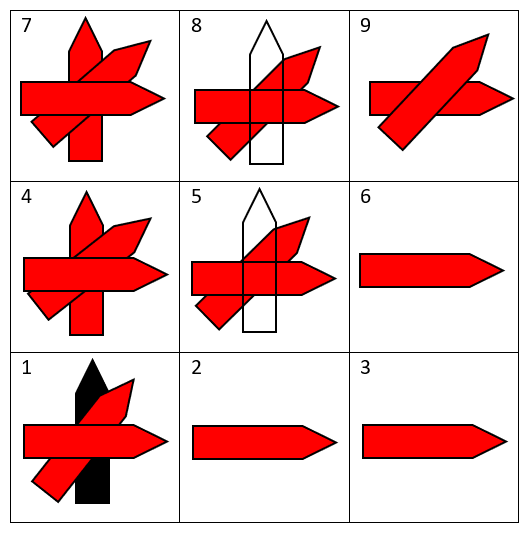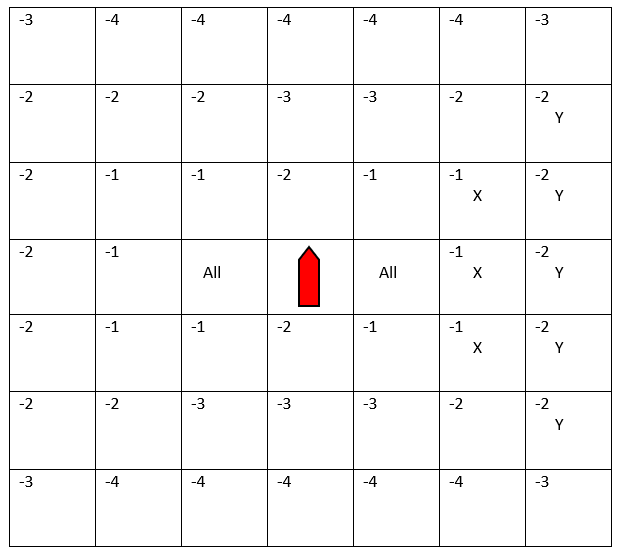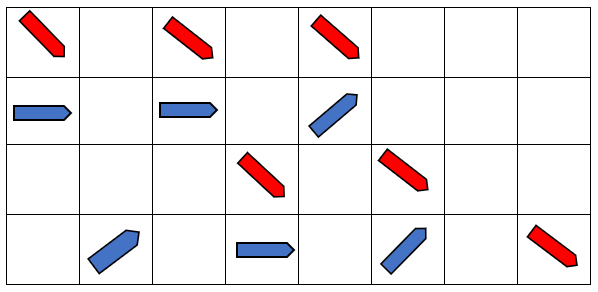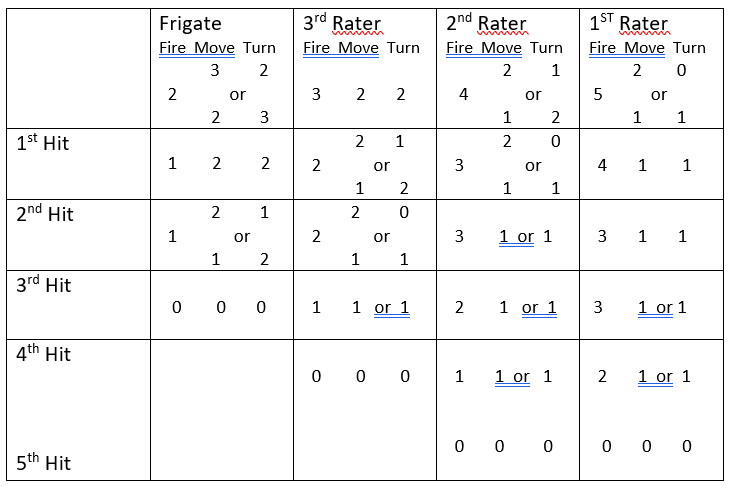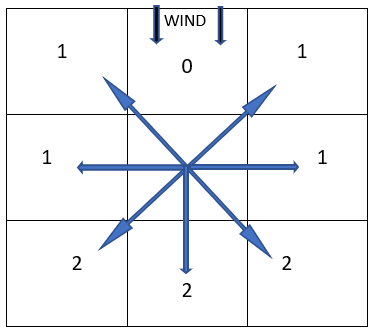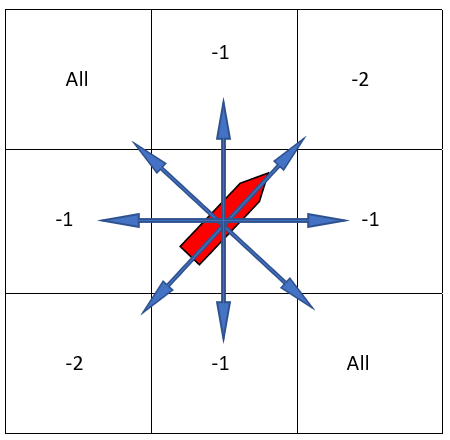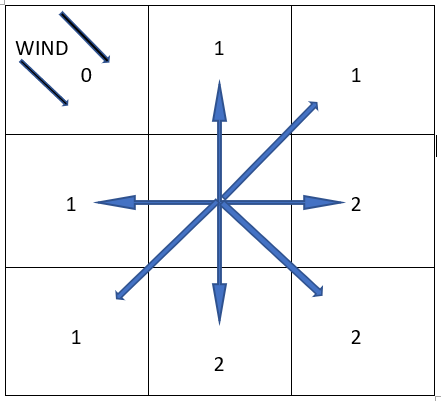
Games (10)
Frontier Space War 4.
Frontier Space War, version 8.
FSW8 represents the latest upgrade to this interstellar conflict system. I have used some high quality metallic spray paints on the card discs showing the star systems and the all-metal ships made out of nuts and bolts, ball bearings, plumbing fittings, masonry and plaster anchors, and some two-part epoxy resin as adhesive.

The five factions here represent: -
Imperials (I), Aquarians (A), Goths (G), Capitalists (C), Soviets (S).
Yet they can represent anything from Neo-Feudal Noble Houses to a variety of Alien Races.
The combat powers of units in attack A or defence D, appear as the type of dice used for such attacks or defences. Icosahedron 20, Dodecahedron 12, Pentagonal bipyramid 10, Octahedron 8, Cube 6, Tetrahedron 4. The system requires 3 sets of attack dice and two of defence dice.
b/3 means best of 3 dice rolls. (1/tn) means only one shot per player turn. (8*) means Destroyers engaged in rounds of combat with Capital Ships denoted *, attack or defend at 8. # means craft may jump past enemy craft during movement, but not enemy # craft, otherise all other pieces must halt on encountering enemy pieces.
Unit. ATTACK DEFENCE COST MOVE
Capital City* - 20 - 0
Fortress* - 20 5 1 NR
Battleship* 12 12 5 2
Battlecruiser* 10 10 4 2
Cruiser/Carrier 8 8 3 3#
Destroyer 6 (8*) 6 2 3#
Frigate 4 4 1 3#
Fort - 4 - 0
Monitor* 4 20 3 1 NR
Devastator(I) 12 (1/tn) 4 2 3
Fighter(I) 6 6 1/3 01
Attack Cruiser(G) 10 6 3 3
Heavy Gunship*(ACS) 20 4 5 2
Katusha (S) b/3 10 (1/tn) 6 2 3
Flagships* as below
(I)(S) As for Battleship, but attack at 20 and add +1 to all dice in flotilla A or D.
(C) As for Battleship, but may deploy its 2 fighters in addition to standard attack or defence 3:2 lineup.
(G) As for Battleship, but b/3 to self and one other ship in flotilla, A or D.
(A) As for Destroyer, but b/3 to self and two other ships in flotilla, A or D.
All worlds must be occupied by a Fort for income. Any Fortress can produce units up to a total cost of 5 per turn. Unused income cannot be saved. Any ship costing 3 or more may place a Fort on a world cleared of opposing forces at no cost.
Player turn: - INCOME(connected systems), PRODUCTION(at Fortresses), MOVEMENT, COMBAT(retreat, out of combat), (PLACE FORTS)
COMBAT – Risk Protocols, up to 3 Attack dice and 2 Defence dice. Attacker deploys first in each round, up to 3 pieces if available, defender deploys second, must place 2 pieces if available. Compare highest two dice throws in order, defender wins draws. Each side removes one casualty of choice for each loss. After one or more rounds of combat either side may elect to retreat 1 jump from the territory, if possible. NR means no retreat option for unit.
01 Fighters can only move in Carriers. Only one active producing fortress per system.
Start – 2 Player game - All pieces on board, at least one ship and a fort per system. Imperials pick 1 ally. Remaining 3 factions ally as Rebels. Alternate All Imperials then All Rebels. Combined ops in attack or defence.
3 Player game. Imperials versus 2 alliances of 2 others. No combined operations.
4 Player game. Imperials inactive due to internal collapse, no production, or movement, defence only. 4 other factions fight for supremacy.
5 Player game. All five factions strive for supremacy. Alliances may form and break but no combined operations except for conquered factions.
Victory Conditions. Eliminate enemy Capitals. Any remaining forces then become subsumed into an alliance with combined operations.
Income from star systems, Large 3, Medium 2, Small 1.
Starting incomes. (I) 19 (A) 15 (G) 15 (C) 16 (S) 14
Optional extra: Psi Weapon Tournament Rules.
Psi weapons run on strange esoteric, AI, and quantum principles to modify material and psychological realities. Factions may purchase them during their production phases at a cost denoted by C. Any faction may hold up to one of each type of the eight Psi weapons. The black and red Psi weapons can attack enemy Psi weapons (or other enemy units) at any distance with an attack denoted by A. All Psi weapons have a defence denoted by D. Any vessel may transport or hold a Psi weapon, but if all available vessels become destroyed, so does the weapon.
Local effect weapons. (Within systems only.)
(6) Yellow – Command Enhancement. Confers +2, A or D on a Flotilla. C4 D6
(8) Orange - Navigation – Allows all mobile vessels in a flotilla to move 3, ignoring # pickets. C5 D4
(1) White – Prescience – Allows a vessel or flotilla to move and make an attack but to completely cancel the entire action if it fails, at the cost of the loss of the Psi weapon. Alternatively, an attacking flotilla with Prescience may require a defending flotilla without Prescience to deploy first in each combat round. C4 D6
(7) Green - Diplomacy – Allows a flotilla to delay its move for a combined operation with another faction. C3 D8
Non-Local effect weapons. (Effects anywhere.)
(4) Blue - Production Bonus - increases production of fortresses to 8. C3 D6
(2) Purple - Fecundity Bonus – increases income from all systems by 1. C5 D4
(5) Red – Attack Magic - attack any Psi weapon. C3 A6 D6
(3) Black – Dark Arts – attack any Psi weapon or may attack any unit. C5 A8 D8
The following chart shows the ideological relationships of the five example factions.
(Individualist)
l
Goths l Capitalists
l
(Mystical) ---------Imperials ------------(Rationalist)
l
Aquarians l Soviets
l
(Collectivist)

Quantum Chess
Quantum Chess, or WPD Chess, (Wave-Particle Duality Chess).
Herewith a simple way to represent quantum effects in a game of chess by the addition of a small number of additional rules.
All the normal rules of chess apply and in addition: -
1) Any piece that can move to two or more empty squares can move to two of them at once by splitting the piece down the middle. (Either saw all pieces in half beforehand or use two pieces in place of each one at the start, on a board which can accommodate two pieces per square comfortably.)
2) Whenever a half piece interacts with an opposing piece, either by taking it or being taken by it, the other half of it instantly re-joins it, and both halves then occupy the position of the taken piece or both halves become eliminated if one of them gets taken.
3) A Player moving a half piece must also move its corresponding other half.
4) Halved pieces occupy squares and block movement and support and threaten other pieces in the same way as whole pieces.
These four rules lead to a challenging but playable game that has many intriguing properties.
A whole piece represents the piece in ‘particle’ mode, it has a definite position. Halved pieces represent the piece in ‘wave’ mode, it could occupy either position, but it will come to occupy a definite position only when it interacts.
At the end of a game, a record of the game that does not include the moves of all the half-pieces that ‘disappeared’ because their corresponding half interacted, will still look like a standard game of chess although some of the moves may appear as legal but as very strange choices.
The following picture shows a representation of Quantum Chess in the early stages of a game, using doubled pieces rather than pieces sawn in half. (The numbers on some of the pieces make it easier to remember which pieces go together.)
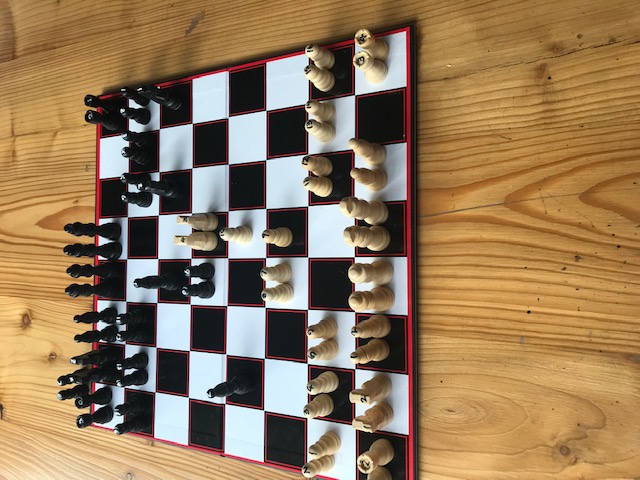
White has taken the Black Kings Pawn with Kings Knight.
Black has replied by moving its Kings Bishop to two possible places simultaneously, one possibility puts White’s King in check, the other possibility threatens White’s Knight.
White now has a quantum problem. White must take its King out of check by either moving it or by moving its Queen or Queen’s Bishop to block, or its Queen’s Bishop Pawn to both block and threaten the ‘possible presence’ of the Black Bishop.
Black can then take the White Knight and the entire Black Bishop will then occupy the White Knight’s square, thus removing any threat to its ‘possible presence’ by the White Pawn.
Black has effectively used a quantum trick to threaten two pieces at once with two possible presences of its Bishop and then taken the White Knight. The result of this manoeuvre looks like a legal move in ordinary (particle) chess, but White’s failure to protect its Knight remains inexplicable if the match record does not include the possible wavelike moves that later disappeared.
Quanta take off and land like particles, but they seem to fly as waves. We can only observe their particle behaviours but from their particle behaviours we can infer their wavelike behaviours.
Imaginary phenomena can have real effects.
Herewith the world’s first fully operational Quantum Chess Piece!


Note the cunning base design which gives extra stability to each of the two halves and helps to secure them together.
Handmade from an ornamental curtain rail endpiece, a length of 2x2 inch softwood, and a disc cut from a length of batten, it took hours with chisels and files, followed by a delicate sawing in half. I don’t have a lathe. I doubt that I’ll try making the other 31 pieces this way.
If anyone wants to manufacture these in say plastic, please let me know, the pawns, rooks, queens, and kings would only require one mould each to this design as they have rotational symmetry about their long axes, the bishops and knights would probably require two moulds for each complete piece.
There follows some general musing on the physics/metaphysics of Quantum Chess: -
Probability – the two halves of each piece represent, in some sense, the probability of its presence on a particular square.
‘Quantum Entanglement’ – the two halves of each piece remain instantly linked over any distance by rule 2 which states that whenever one of them interacts with another piece by taking it or becoming taken by it, then the other half of it undergoes a ‘Wave Function Collapse’ and instantly re-joins the interacting half.
‘Quantum Superposition’ – we can regard the two halves of a piece as representing a quantum superposition when they occupy the same square.
‘Quantum Ontology’ – this model offers as many questions as answers about the reality underlying quantum phenomena: -
Does a piece in wave mode ‘really’ exist in the same way as a piece in particle mode? The wave modes can undoubtedly influence the progress of play, but we can still create a record of the game that does not include them or break the rules of ordinary ‘particle chess’.
Does the wave function collapse of an interacting piece look remarkably like retroactive causation?
If each particle piece can do two different things at once by splitting into two wave modes, does this imply Multidimensional Time?
Technical notes on play - the rigorous application of the standard rules of chess plus the additional quantum chess rules, only allows pawn particles to split into waves on their first move when they can move one and two squares forward simultaneously. There seems no reason to forbid a player moving the two wave components of a particle piece to the same square to recreate a single particle piece, but this will rarely prove advantageous.
Checkmate and ending the game – Placing the opposing whole King in checkmate wins the game and so does placing either half of an opposing King. Note that a player with half a King in apparent checkmate may have the option of taking an opposing piece with its other half thus evading checkmate. At the end of a game players can elect to collapse any remaining wave positions by moving either one of two halves of the same piece to a square occupied by one of them, but the two halves of a halved checkmated King must move to the square in which checkmate occurred. This restores the semblance of an ordinary game of standard chess.
Quantum Chess, Q-Chess, WPD-Chess, Copyright Peter J Carroll 09/10/2021
Spacehulk
Herewith the Exuberant Desolation, perhaps the first of a series of starship models made entirely from scrap materials from the beach and surrounding construction projects. It may eventually form part of a fleet for the spaceraid game here, or perhaps it will feature in a sci-fi novel.

After all, the best games work rather like novels which tell a memorable story with the added advantage that readers become participants and editors within limits.
Perhaps the Exuberant Desolation's AI accidentally achieves full self-awareness and sentience, absconds from the Synarchist Fleet, and spends centuries as a privateer wreaking havoc, gathering allies, and spreading rebellion and revolution.
Square Rigger Chess
Square Rigger Chess models the manoeuvre and combat of square rigged naval ships of the Napoleonic period. No element of chance enters into this system, the results depend entirely on player skill and the chosen starting conditions, to this extent it functions as a chess-like game. This modelling system depends on several simplifications for game play: -
The division of sea areas into squares. The orientation of all ships and firepower and wind direction, in just 8 possible directions. The characterisation of ships by just 3 factors, Firepower, Speed, and Turning ability. F, S, and T.
Firepower. – (the combined effects of cannon + carronades + mortars + musketry), ships begin with a firepower factor of 2, 3, 4, or 5. In attack a ship may allocate its firepower factor in any directions preferred up to the maximum of its firepower as shown in the Fire chart following: For example, a 2Nd Rater with a firepower of 4 could direct all its firepower of 4 in a starboard (right) or port (left) broadside, but not both. It can only use a maximum of 2 units of its firepower (4 – 2 = 2) fore or aft and only a maximum of 3 units (4 – 1 = 3) off the port or starboard bows or off the port or starboard stern, thus it could for example simultaneously fire 2 units of its firepower fore and the other two off the starboard bow, (or any other direction chosen). In combat the attacker assigns firepower factors to chosen directions first.
The effect of attacking firepower falls off with distance, by 1 per every square after the immediately adjacent square effect shown below. (See the Distance Fire Chart later.)
Ships defending against Fire use their Firepower factor in the same way, assigning part or all of it to various directions to try to cancel the effects of incoming fire, however it does not decrease with distance. This curious seeming rule reflects the fact that the vulnerability of ships rose in precisely those directions where they could use the least of their firepower.
Any ship which receives from any direction more firepower than it assigns to that direction takes one ‘Hit’ for every unit of firepower that it loses by. Merchant ships have defensive ‘firepower’ only.
Speed and Turn. In a player turn ships may move one square forward for every Speed factor they have and may turn 45 degrees (one eighth of a full circle) for every Turn factor they have.
The chart below shows what manoeuvres a 3rd Rater with a Speed of 2 and a Turn of 2 can do in a move with mainly starboard turns.
The nimble 3rd Rater starts on square 1, its initial position shown in black. It can end its move in any of the positions shown by red ships by using some or all of its 2 Speed and 2 Turn capabilities. Note that it could also use turns to port instead of starboard to end up in the positions and orientations shown by the white ships and that it could also make other orientations on squares 4 or 7 using turns to port. (Not shown).
The heavier ships have less manoeuvrability than a 3rd Rater, and manoeuvrability declines as ships take Hits (see damage chart).
Wind direction and intensity also affect manoeuvrability (see wind rules and chart).
Ship Classes.
First Raters. F5, S1, T1. These rare lumbering behemoths with 100+ guns have huge firepower but poor speed and manoeuvrability.
Second Raters. F4, S1, T2. As above but these monsters with 84 guns do manoeuvre slightly better.
Third Raters. F3, S2, T2. These faster and more manoeuvrable 64-gun warships serve as the main workhorses of the line of battle.
Frigates. F2, S2, T3. These fast and highly manoeuvrable 44-gun warships can bring vital extra fire support when heavier ships engage.
Distance Fire Chart.
Firepower has its greatest effect into adjacent squares, but ships may also use their firepower at greater distances. Basically, subtract one from the effect of assigned firepower for each additional square. Thus, if the vessel below has a firepower of 4 and assigns it all to a starboard broadside that broadside can only have an effect of 3 on any one square marked X, or 2 on any one square marked Y.
The Non-Adjacency Rule. Ships on the same side must leave at least one empty square (orthogonally or diagonally) between themselves when ending their player moves.
This rule may seem slightly unrealistic, although friendly ships did try to keep at least a ships length between themselves.
This rule allows for the use of the classic manoeuvre of ‘cutting the line’ without the complications of modelling collisions. Ships on opposite sides can occupy adjacent squares, and they will often do so to disrupt enemy formations and to direct the fire of several ships to a single target.
The above chart shows a flotilla of red ships engaging a flotilla of blue ships. Note that whilst several ships from either side have moved to squares adjacent to enemy ships, no two ships on the same side lie orthogonally or diagonally adjacent to each other.
The non-adjacency rule does not apply inside of harbours, friendly ships may moor and manoeuvre alongside each othear, ships may also lay adjacent to friendly ships that have struck their colours.
Damage Chart. As ships take Hits, their Firepower, Speed, and Turning abilities decline as shown on the following chart. Players should place damage markers on their ship markers as appropriate to show their status.
Any ship reduced to 0 0 0 ‘Strikes its Colours’ and remains immobile and inactive for the rest of the battle and subject to towing away for repairs or as a prize afterwards, if the victor has a mobile ship spare to do this, otherwise the victor may elect to scuttle it.
Wind Chart. Players set the wind direction and intensity before play, the wind can come from any one of 8 directions. Players may also make some provision for a change of wind during the game if desired.
Moderate Wind simply prevents movement directly into the wind (square riggers could not do this), however they can turn into the wind and then turn to 45 degrees to the wind and effectively tack in a zig zag in a generally windward direction.
Stronger winds also deny movement directly into the wind and additionally allow for greater movement with the wind as shown in the chart below. The numbers on the squares represent the number of squares a ship can move in that direction for the expenditure of a single speed point. Ships can move twice as far with a following stronger wind.
General notes on scenarios and tactics. Players should practice with small numbers of ships at first. Larger flotillas and fleets may require the command of several Commodores or Admirals each in charge of a squadron, as coordinating the movement and fire of many ships becomes a challenging task.
Scenarios can include convoy interception (see note on transports and merchant ships), chasing down and capture of slow enemy heavy ships by more numerous lighter ships, harbour blockades and attempted breakouts, and fleet battles for naval supremacy.
Transports and Merchant Ships usually effectively consist of unarmed versions of naval ships, with the heavier ones having less speed and manoeuvrability. They take damage and strike colours in the same fashion.
Play takes place by alternate moves. In each player move players may move all their ships in any order so long as the final positions of their ships does not break the non-adjacency rule. Attacker and defender then both assign firepower in exchanges of fire, calculate Hits and place damage markers.
The following 2 charts show for extra clarity, firstly the effects of fire from diagonally orientated ships, and secondly the effects of stronger wind from diagonal directions.
Shore Batteries. These defend harbours and effectively act like static ships with high firepower. They should have precisely designated fields of fire. They take firepower damage in the same way as ships.
Commanders should learn to recognise the lines of squares which stretch out from the port and starboard bows and the port and starboard sterns of any ship, for these represent the ‘true diagonals’ of the ship itself, (whether the ship lies orthogonally or diagonally on a square), for these define its fields of fire and defence.
Note that Frigates begin with no ability to fire directly forward from their bows, or directly backwards from their sterns, and no defence against fire from these directions either. Theoretically negative values for defensive firepower do not invite extra damage hits, negative values simply count as zero.
The Necronomicon Mythos Simulation


 The second expedition to the Necronomicon Mythos by Psychonauts of Arcanorium College continues to produce strange and unanticipated results.
The second expedition to the Necronomicon Mythos by Psychonauts of Arcanorium College continues to produce strange and unanticipated results.
From Hastur I received the following inspiration to complete a task that has bugged me all my life, to make some sort of simulation or boardgame that models the magical quest itself.
I have made many games in the course of a lifetime that model various real and imaginary scenarios, with the underlying thought that if you can identify the mechanisms underlying any system then you can perhaps understand the dynamics of it, and perhaps do it better in the game of ‘real’ life. Strategy Games certainly seem to sharpen the mind, and may bring us some focus on the Human Condition.
Yet most of the games involving magic that I have collected or read the rules of seem unsatisfactory. Magic typically appears only as a combat modifier in battle games, rarely as the focus of an activity or a quest in itself.
In this Hasturian inspired simulation the Elder Gods and their Knowledge and Power stand as metaphors for the abilities we humans seek in the quest for personal and species survival. They represent abilities we need to survive the future, not ghastly eldritch cosmic adversaries bent on our destruction, although with careless use they could have that effect.
Hastur may appear as an empty yellow robed void, countless aeons old, a well of cosmic indifferentism, yet it seems to take an occasional whimsical interest in promising species, perhaps to allay its existential angst awhile.
The concepts of the simulation may seem cruel and cynical; individual questors inevitably die although they may achieve much before senescence and mortality take hold. The numbers used to represent various factors all come from my calculations in an attempt to render the simulation realistic.
Oddly, the whole thing begins to look strangely autobiographical although several treasures still elude me. My own mistakes and that of others have become obvious during the course of many runs of the simulation. The virtues of maintaining a high Sanity, particularly in the early stages of a quest, become all too apparent.
Build it, try it, and send feedback and questions.
Game of Thrones Risk Deluxe Solo
Game of Thrones Risk Deluxe.
I enjoyed the Game of Thrones so much that I arranged to receive the board game for xmas. Okay, so it follows the usual Risk format which provides a reasonable ‘beer and pizza’ evening for 5 or 7 student age people if you play it straight. However the beauty of the map and the pieces led me to wonder if I could get more out of it by using it to tell a longer story as a one player game over a number of evenings, rather as one might enjoy reading or writing a novel within defined parameters.
Herewith my rough house rules: -
Setup on the Westeros board only.
Each house occupies all of its own territory, plus use the red pieces for the Iron Islanders.
Use the blue pieces for neutral territories (Vale of Arryn, Riverlands, Stormlands.)
Place the blue citadel on Kings Landing as a second Baratheon citadel.
Each territory generates 1 troop unit, as does each town and each port, citadels generate 3 units.
Each town and port and citadel generates 1 (100) gold.
Ships – I used the galleons out of ‘Civilisation’, you need about 10 ship markers. Each house starts with one, except the Iron Islanders who have 2. They begin and end turns in ports.
At each player turn, 1) adjust forces and income as above. 2) move any troops 1 space within occupied territory. Spend income if desired on fortifications, catapults, knights, reinforcements, or treachery.
Costs, fortifications, catapults, knights, ships, 3 gold each.
Treachery, to subvert an adjoining enemy unit pay 1 gold and throw a 2 or less on a D6, pay 2 gold and throw a 4 or less, or pay 3 gold and throw a 5 or less to change that unit to one of the active players own house. This only works at all if all units on a territory plus knights become subverted, otherwise it all fails, and the gold wasted.
Attack any neighbouring territories from ones you initially own. Ships carrying troops may attack up to 4 ports away, and may sail around the bottom of the map but not the top.
The usual rules of combat apply but with the following modifications, you can employ multiple knights and catapults, so towards the end of the game the 8 sided dice get used more. (you may need an extra 8 sided attack dice)
Citadels offer +2 to defenders on dice but only if the defenders elect to retreat to the citadel for a siege. Attackers can elect not to assault but to lay siege, in which case they own the territory, towns, and ports associated. If after 3 turns the siege remains in place, the defenders become eliminated.
Naval warfare. If a defender elects to defend an attacked port with ships then each ship can have a fighting crew of up to 3 troops plus up to 3 knights and one catapult if available, it may also carry another 3 troops as transports but not combatants. If a ship losses all three combat troops it becomes sunk, along with transports.
Ships can land troops on any territory to which a white line points even if it doesn’t count as a port, but then the ships must retire to their nearest friendly port.
Undefended ships in ports become automatically captured if attacked by crewed ships.
The single player should play each house in turn, considering the strategic options as they arise. Obviously alliances will become a critical consideration and part of the developing narrative. One simple rule can suffice here; any house breaking the terms of an alliance has to forgo all of its income in its next turn.
Objective- dominate Westeros, or at least form a stable alliance between the surviving houses.
Extra feature, when the last of the blue neutral pieces become eliminated the Undead as blue, begin to invade the The Gift. Roll a D8 to see how many appear each turn. They attempt to move south 1 territory per turn rolling D8s. Destroyed opposing pieces become replaced with undead pieces if they capture territory.
Favorite Games
Herewith a list of games that have particularly intrigued me over the years, some remain in print, some you can find easily on the net, others remain personal creations or in development. Games have made a considerable contribution to my thinking since an early age, not perhaps as much as books, yet interesting games function a bit like a books, and not only do they have a stories to tell in their structures but you can evolve stories as you play them or adapt them.
Careers. https://en.wikipedia.org/wiki/Careers_(board_game) I came across this at about age 12. I knew little about the world in those unsophisticated times and attended a grammar school where the English Master (a wily and provocative old cove) would occasionally announce ‘You are here to be educated as clerks, like your fathers’. Fortunately the school also had a science department, although nobody had a clue what you could do with a science education except become a science teacher. The school gave no career advice, it assumed you would either take one of the plentiful clerical jobs available at the time, or go to university and think of something whilst there. The game of Careers thus seemed an astonishing eye opener. Choose Wealth, Happiness, or Fame, join a whole series of professions, buy a yacht, in short; choose an Identity! All this seemed to sit in my subconscious till the mid-1970s, an era of plenty when career-anxiety seemed to give way to the search for personal identity in my peer group. I guess that I have always looked at life as a sort of board game. A lot of the assumptions built into the Careers game now seem simplistic but eventually it would perhaps have some influence over what I wrote in EPOCH, but more of that in a following article.
The Game of Nations. This came out in the 1970’s to model the then current oil crisis. Players control abstract Middle –Eastern oil producing territories and vie to get wealth that they can spend on oil extraction, tankers, and pipelines, or on taking over adjoining territories. The game system does not involve dice but it does have uncertainties built in with event cards. Players can buy Politicians, Secret Agents, Monarchs, Dictators, and Guerrillas in an attempt to subvert or conquer additional territories. Today we should perhaps consider adding Theocrats as well, and making the map less abstract and updating the events cards.
The Russians currently seem to play a strong hand in Syria. The West has perhaps made a mistake in supporting the ‘moderate’ rebels. Both sides need Iranian cooperation and support but if the Iranians come out of this on top then all hell may break loose if they go head to head with the Saudis.
Diplomacy. This classic game of early 20th Century European alliances represents one of the few games which model WW1 in an interesting way. Apart from the naval battle of Jutland the battles of WW1 mainly got settled by terrible attrition rather than by interesting tactics and manoeuvres. In Diplomacy we see the bigger picture as nations make secret alliances and agreements off board and then simultaneously reveal their strategies to see what results. Historians argue constantly about the causes of WW1, but in this model scenario, war seems virtually inevitable if the game represents the actual diplomatic system of the time. The game however does really need 5 or more players, but you can play it over many days with perhaps a move a day, and with secret diplomatic notes passed around at tea and lunch breaks.
Axis & Allies. The basic Axis & Allies game models WW2 from after it has started and Japan has attacked Hawaii and the Germans have attacked Russia. It can accommodate five players but it works well with just two. Basically it works a bit like the simple strategy game of ‘Risk!’ where you get extra forces for conquering more territory, however the forces consist of various types of land, sea, and air units which makes it far more detailed and engaging. Subsequent versions have striven for yet more detail and realism. The initial game suffered from the structural quirk that Japanese commanders with any sense should disengage quickly from the pacific and attack Russia in the east, thus virtually ensuring an Axis economic victory. However for historical reasons, notably the Nomonhan Incident, the Nazi-Soviet Non-Aggression Pact and an Oil Embargo, they adopted a Pacific strategy. The critical role of oil supply in WW2 does not seem well reflected in the basic rules.
Buck Rogers – Battle for the 25th Century. This quirky game never became very popular but you can get second-hand versions quite easily. It has an Axis and Allies type strategic structure but set in the inner solar system with spaceships and spacefaring troops disputing the control of Mercury, Venus, Earth, Mars, the Asteroids and various orbital facilities. It has the extraordinary feature of a variable geometry board. The Planets move around the Sun and you need to plan spacecraft trips accordingly. The basic game has some complications that I don’t find worthwhile; I have preferred to adapt the rules to make it more like Axis & Allies and also to use the Risk 2210 sci-fi pieces to provide more choices of troop type.
Discworld. Ankh-Morepork. Something extraordinary happened here and then a tragedy occurred. Perhaps by some happy chance a really good game got cobbled together in Ankh-Morepork, (two attempts to make sequels to it fell badly flat) but then after the death of Sir Terry Pratchett something went wrong with the rights and the publishers had to stop making it. Sets can now fetch several hundred pounds. The game has a bit of everything, it seems a bit like turbo-monopoly with assassination and magic, although amassing property may not necessarily win you the game because you don’t know which characters your opponents play. It works best with four players and it contains enough randomness and pageantry from the books to make it surprising and enjoyable for aficionados and beginners.
Space Raid. Interstellar board game design presents two major problems, firstly how to represent 3D space on a 2D board, and secondly how to allow for the vast distances and speeds involved. The designer needs to invoke or invent some reasonably credible but as yet undiscovered physics.
In designing Space Raid, I opted for sheets of black board with numbered or named stars on them joined by pale green lines representing possible jump routes between them of lengths of up to a few parsecs, to produce a sort of spider web or network of jump routes with the stars at the nodes and with most stars connected to between 2 and 4 others by jump routes. On the board the jump routes have different apparent lengths to represent the reality of the stars not all lying in exactly the same plane, but perhaps lying in the thickness of the plane of a spiral galaxy.

The starships move using (hypothetical) gravity focussing devices. By focussing the gravity drive exclusively on a nearby star, a ship accelerates towards it and achieve an immense velocity fairly quickly. It then performs a slingshot manoeuvre around the star and as it hurtles away it uses the gravity focussing drive to brake against the star to eventually bring itself more or less to rest around another nearby star. Thus each time a ship makes a jump it leaves one star system, hurtles through another without stopping, and ends up in a third. Two further quirks of relativistically dubious speculative physics also occur in this scenario, initiating a jump sends out a non-local gravitational hyperwake through the system so all ships know when another has jumped, but not to where, plus all jumps take a very similar amount of time, irrespective of differing distances.
Rather conveniently this leads to the situation where all ships on both sides can jump simultaneously but commanders don’t know the destinations of their opponent’s ships. So both sides secretly write down the next destinations of their ships and then both reveal them and move their ships and see if any have arrived at the same star systems, in which case combat begins. Plus ships passing through a star system in the middle part of their two star jump have such an enormous velocity that interception and combat remain impossible, however they can deploy kinetic energy weapons in passing, basically dropping rocks on very large targets like planets to create massive devastation. No defence exists against this except to intercept them well before they get within jump range of a star system with a base or colony on one of its planets. This does not seem unreasonable, the capacity for flight soon brought with it the capacity to wreck entire cities; the capacity of interstellar travel would probably bring with it the capacity to wreck entire planets. Players may agree to a treaty forbidding such tactics, or a severe loss of victory points if they break it.
When opposing starships end up in the same system they can attempt to engage or evade each other using a variety of sensors, cloaking devices, and evasive tactics, force shields, particle beam weapons, and missiles. Each ship has a variety of factors for these and duelling proceeds through the use of asymmetric combat polygons. Ships can also exchange fire with orbital bases or with planetary bases.
Asymmetric Combat Polygons
Asymmetric Conflict Polygons
Uncertainty in games can come from either building in randomness with dice or shuffled cards or some other sortilege procedure; or from scenarios where players lack information about their opponent’s intentions.
Simultaneous Play often yields a system that models real life scenarios rather well. In this, the players secretly record their intended plays and then all reveal their orders and compare them to see what happens. The game of ‘Diplomacy’ which simulates the political alliances and military balances in Europe from 1900 onwards provides a classic example of a game based on simultaneous play with concealed intentions. Only rarely does peace prevail until 1914.
Some people find the use of dice or some other random mechanism unappealing as it can make the best laid plans come to nothing for no reason except bad luck, and it prevents any detailed analysis of a game afterwards.
The game of Scissors-Paper-Stone, sometimes called ‘Roshambo’, may well originate from the Han Dynasty era in China. It has attracted a considerable amount of study and competitive play, and computer algorithms exist against which humans can play. Although no strategy can consistently beat purely random play, competitions and algorithms remain interesting because few people can consistently play randomly and a good player or algorithm can anticipate the non-random choices of an opponent based on their previous choices.
Nevertheless the game remains rather trivial although the principle has become incorporated into some games to settle combats between pieces, for example in hand to hand conflict, Parry and Thrust beats Lunge, Lunge beats Slash, and Slash beats Parry and Thrust, or something like that. To a very simple approximation circa 1805, Artillery beats Infantry, Infantry beats Cavalry, and Cavalry beats Artillery.
Such a system of conflict resolution leads to a quick and easy type of duelling done with hand gestures, or with cards selected and put forward and then exposed. Yet in its simple form it seems little better than using dice. However by using something a little more sophisticated than a simple symmetrical triangle of outcomes we can create a facility for meaningful tactical choices with some uncertainty of outcome.
Consider the virtues of Asymmetric Conflict Polygons. An Hexagonal one appears below.
In this the six choices can represent any tactic from the exchange of fire between starships to the exchange of spells in a magical duel. The arrows between tactical choices show which choice wins and the weight of the arrow can show by how much. Each player in the duel has six cards marked with the tactical choices and both draw a card and then they simultaneously expose them and find the result. The asymmetries in the chart make some choices more favourable than others, depending on the powers of the pieces involved, however obviously the opponent will appreciate this.
The actual chart shown has the design feature that no choice offers guaranteed immunity from a full hit, but some choices offer greater chances of some kinds of hits.
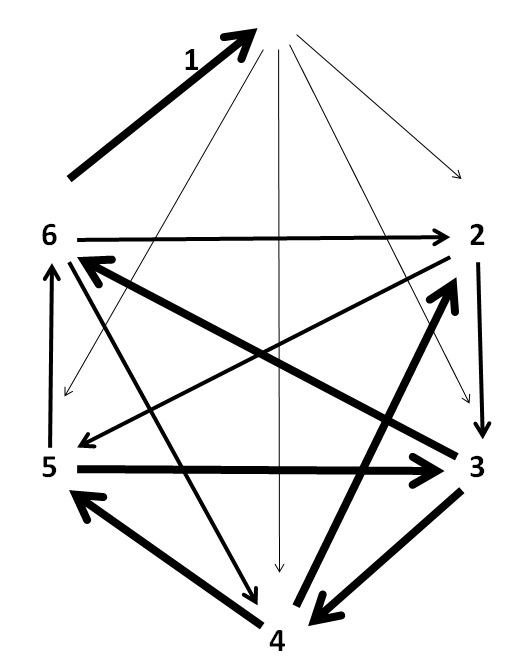
We could display the information on such a polygon with a simple 6 x 6 chart, however the polygon itself gives a much easier to use representation of the effect of one tactical choice upon another and the opportunities for second guessing the opponent.
Conflict polygons can also model the effects of offensive against defensive tactics where the attacker draws an attack tactic card and the defender draws a defensive tactic card.
In solo play an asymmetric polygon can allow the player to compete with intelligent choices against random choices generated by dice rolls.
Napoleonic Chess
After decades of creating games of sometimes almost unplayable complexity the following game of Napoleonic Chess just sort of fell into place as part of a dice-free battle resolution system within a much larger strategic geo-political and economic game scenario. (I still work on that, particularly the naval aspects.)
However the game of Napoleonic Chess ™ has such an elegant simplicity and playability to it that I declare it Copyright Peter J Carroll 16/2/2016 ©.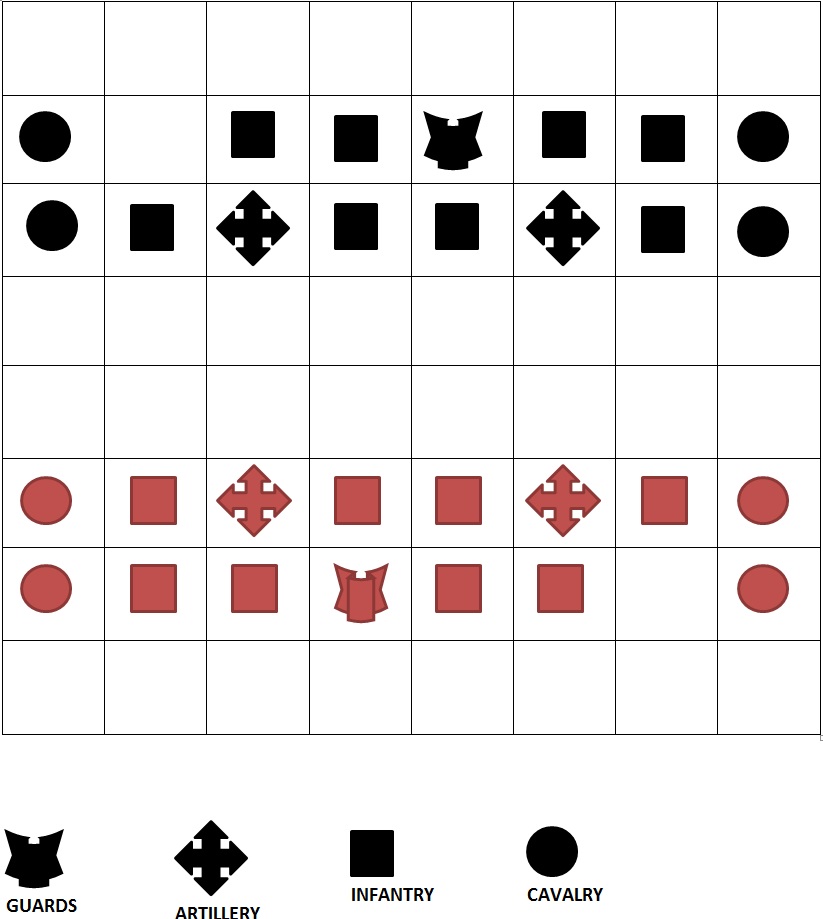
Napoleonic Chess.
A tactical game system for Napoleonic era battle simulation which players can use on an ordinary chess board using chess pieces, or extend to larger boards, add terrain features, or add additional units. This system differs radically from chess in that players may move all of their pieces in their turn.
The basic rules for the Standard Scenario appear below, followed by suggestions for more sophisticated scenarios.
Standard Scenario.
Players set up as shown with units on the 2nd and 3rd and the 6th and 7th rows. If using a standard chess set, discard the queens; use the pawns as infantry, knights and bishops as cavalry, rooks as artillery, and the king as guards. Alternatively for a better appearance and ease of use, take 2 chess sets and use all the knights for cavalry and both queens for artillery on each side. Alternatively acquire or make some period pieces.
Each side moves alternately and settles all resulting attacks, and each player may move all their units during a single turn.
Movement and Combat. Units basically move (or not) and then attack in a single turn.
Infantry may move a single square in any direction.
Infantry attacks or supports orthogonally only, with a value of 1, into an adjacent square. Infantry has a defensive value of 1.
Cavalry may move one or two squares in any direction.
Cavalry attacks or supports diagonally only, with a value of 1, into an adjacent square. Cavalry has a defensive value of 1.
Artillery may move a single square orthogonally only.
Artillery attacks orthogonally only with a value of 2, into an adjacent square.
Artillery supports into an adjacent orthogonal square with a value of 1.
Artillery has a defensive value of 1.
The Guards may move a single square in any direction.
Guards attack or support in any direction with a value of 1, into an adjacent square.
Guards have a defensive value of 2.
Any unit may make only a single attack or defensive support in a players turn, or a single defensive support against attack in an opponents turn.
Eliminating pieces.
Any unit coming under attack by attack values which exceed its defence value plus the value of any support it receives becomes eliminated and removed from the board.
One of the attacking units may then move straight on to the square it occupied if the attacker so wishes.
A unit under attack cannot offer support to an adjacent unit.
Victory Conditions. Elimination of the enemy Guard unit; or the enemy surrenders.
Example of a complex attack.
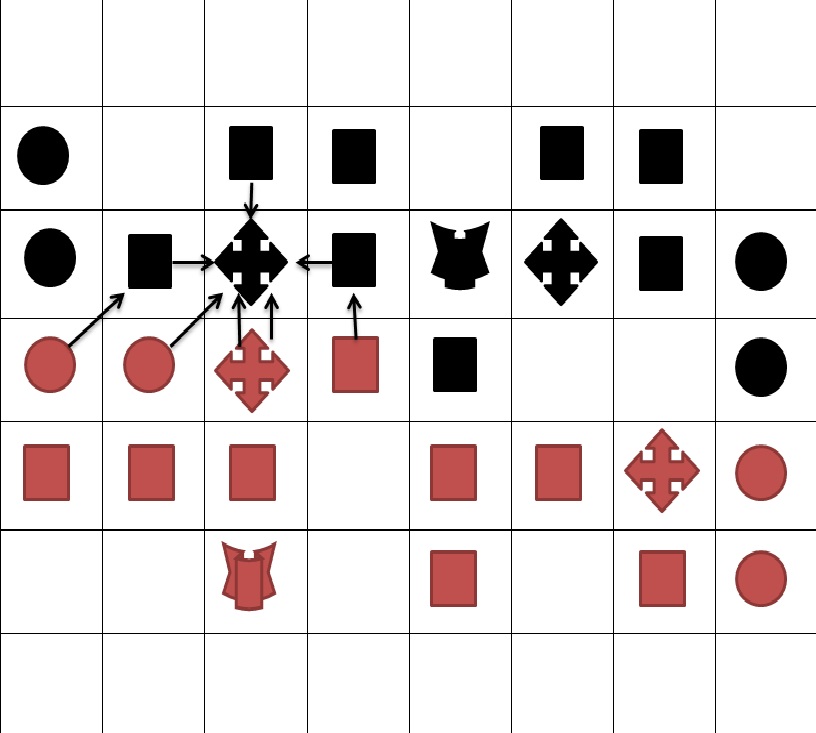
Here Red attacks the Black Artillery unit with Artillery. The 3 orthogonal Black infantry units support the Black Artillery but the support of the ones on either side becomes removed by attacks from Red Infantry and Red Cavalry, so it only has support from the Black Infantry behind so it has a total defence value of 2, whereas Red attacks it with an attack value of 3, one from the Red Cavalry and two from the Red Artillery, so it becomes eliminated. Red then has the option of immediately moving either the attacking Red Cavalry unit or the Red Artillery into the vacated space. (Although this would prove very risky).
Advanced Scenarios.
1) Alternative Standard Scenario Initial Dispositions.
a) Attack at Dawn. Both sides write down their desired positions of their units on the 2nd and 3rd and the 6th and 7th rows in secret and then reveal them and lay out their units.
b) Marching Orders. Players take it in turn to place one unit (or more if agreed) on the board at a time in the appropriate rows till all units have become deployed.
2) Additional/Variant Units.
Horse Artillery moves 2 squares in any direction.
Horse Artillery attacks and supports in any direction into adjacent squares with a value of 1.
Horse Artillery has a defensive value of 1.
Dragoons move two squares in any direction.
Dragoons attack and support into orthogonal squares only with a value of 1.
Dragoons have a defensive value of 1.
Foot Guards, as for Infantry but with a defensive value of 2.
Cuirassiers/Horse Guards, as for cavalry but with an attack value of 2.
3) Optional Terrain Features. (Made by placing an appropriate card tile on a square)
Hills – add one to the defensive value of a unit on a Hill square unless attacked from an adjacent hill square. Units cannot move on and off a Hill in a single turn.
Redoubts - (earthworks etc.) - these take an agreed number of turns of uninterrupted occupation of a square to construct, and then function as for Hills. Artillery attacking into a redoubt attacks at only 1, and cannot enter an enemy redoubt on the same turn if it falls.
Square Border Obstacles – watercourses, banks, ditches hedges etc. – These can mark one or more of the edges of a square. They give +1 defensive value if they protect a unit from all units attacking it. Artillery has only an attack value of 1 across such obstacles.
4) Larger Boards, Bigger Battles with More Units, Multiple Armies, Multiplayer, Divided Command and Strategic Scenarios.
This system will support all of the above. Allied units from different armies or command structures may support each other by attacks without moving, or by supporting in defence.
In Strategic Scenarios stretching over continents and using markers for entire armies, this system provides a means of resolving battles at a tactical level.
In larger battles it often helps to number the pieces to keep track of which have moved and which haven’t in a turn. 1st, 2nd and 3rd infantry etc.
Other Epochs. This battle system can support a variety of pre-gunpowder conflict scenarios by simply substituting Heavy Infantry for Artillery.
Welcome to my Games pages
Academic Games Theory concerns itself with decision making in abstract, theoretical or hypothetical situations in the hope of working out what decisions agents might or should take in the real world. As such it has attempted to model tactical and strategic behaviour in many fields from gambling and criminality to economics and warfare. Biologists have even tried adapting it to explaining hunting and mating strategies.
The famous Prisoners Dilemma in which two subjects have to choose between incriminating the other or keeping silent has many variants, but basically if both keep silent they both get a small sentence; by incriminating the other, either can go free but with the other getting a large sentence; however if both incriminate the other then they both get a fairly large sentence.
However this theoretical scenario does not easily model the real life behaviour of the police who invariably try to separate suspects and to heavily hint that their associates have already incriminated them, or the degree of honour or animosity between thieves.
The modelling of economic behaviour used to depend entirely on the ‘Rational Agent’ proposition that people will always act to maximise their monetary gain. However experiments tend to show that people have an irrational aversion to loss, regretting the loss of a small amount more than valuing the gain of a larger amount, and that they tend to suffer from the sunk costs fallacy and throw good money after bad, and that they generally conform to herd mentality, and that they frequently invest in Meaning rather than Utility. Yet even with such added sophistications ‘The Dismal Science’ of Economics still has very low predictive power.
Warfare, the game of kings, has invited theoretical modelling and representation since the earliest of times with the game of Chess and its oriental equivalents providing prime examples. However such semi-abstract games lack the complexities of real warfare and combative nations have never agreed to settle conflict by simulation, except perhaps for the nuclear standoff conflict where most simulations simply offered Mutually Assured Destruction or Not, and they chose Not.
Personally I hate straight Chess, it seems to require far more concentration than imagination and its very abstractness does not fire my imagination. There seems little point in playing except to win, and playing to win, particularly against computer programs, just gives me headaches for very little reward. Playing to win against friends tends to sour friendships. On the other hand some board wargames have an intrinsic pageantry or historical interest or imaginative component that makes the play itself interesting, win or lose.
I also hate Monopoly because of its complete lack of realism, you get money for nothing, go to jail for no reason, the rent and taxes come in randomly, you have no choice of movement, it doesn’t teach you anything about capitalism, it takes far too long, and play doesn’t improve much with practise because like most ‘family games’ it involves a great deal of chance.
Uncertainty and chance provide much of the fascination of games and perhaps the only rationale for war or perhaps for even living at all. Yet uncertainty comes in two forms, lack of information and randomness. Some philosophers and classical physicists will argue that randomness simply consists of our lack of sufficient information. Other philosophers and most quantum physicists will argue that randomness actually underlies the apparent order of the universe which doesn’t really have a deterministic future state. Either way for the purposes of argument here we shall regard fair dice as ‘fair’, i.e. random in their output.
The appeal of uncertainty seems to lie in the pleasure we get from resolving it which tends to arise as either as a feeling of surprise and discovery and/or of control or vindication.
The degrees of imaginative symbolism, chance, imperfect information, and decision making, seem to define the quality and appeal of any game.
Games of pure chance rarely have much intrinsic interest except for those deluded by various gamblers fallacies, those who know how to cheat, and those with the mathematical expertise and investment capital to offer gambling facilities.
Snakes and Ladders seems utterly tiresome and pointless, and a bizarrely misguided attempt to model moral principles (originally it had all the ladders labelled with moral virtues and all the snakes labelled with moral vices) because ‘players’ have no choices at all in this game of pure chance.
Perhaps Snakes and ladders has its ultimate origins in the Neoplatonism that spawned Gnosticism, Hermeticism, and Kabala in the first couple of centuries AD, for these have various emanations, archons, and sephiroth that the supplicant must ascend like some sort of ladder to heaven. The Kabbalistic Tree of Life in its later representations has a downward pointing sword of the cherubim and an upward climbing serpent of wisdom.
Some people have looked to games of chance as a means of divination, presumably on the basis of the hypothesis that two unknowns like the outcome of the game and the outcome of reality, should have correlations because they already have the correlation of both having uncertainty at the outset.
Chess on the other hand contains no element of chance; the uncertainty arises purely out of the lack of knowledge of one’s opponent’s detailed intentions. The power of a chess piece depends only on its movement and a weaker piece may take a strong piece as readily as an even stronger one can, plus players may only move one piece per turn, both of which render the game almost entirely abstracted from real conflict.
The best strategy games usually involve decisions and choices, and uncertainties arising from both concealed intentions and chance. In these, the role of chance usually kicks in at a fairly low grain size within the game to settle tactical outcomes that the game does not model in detail but it does so in a weighted fashion to reflect the probability of the outcome. If in Chess, pawns and kings threw 1 dice, knights and bishops threw 2, rooks and queens threw 3, and the highest score won each attempt to take another piece, you could convert it into a simple poor relation of a battle game with weighted chance. Alternatively the use of Polyhedral Dice as actual playing pieces with the more multi-faceted ones representing the more powerful pieces, works quite well.
‘Risk!’ the game of world conquest, appears as the grandfather of most popular multiplayer strategy games and it keeps getting released dressed in yet another historical or futuristic format almost yearly. I tend to buy these up just for the pieces these days as you can get a large Napoleonic, or Fantasy, or Science Fiction army of playing pieces very cheaply due to the continuing popularity of the fairly simple game system itself. This system depends on conquering territory to get more armies to conquer yet more, with a numbers weighted chance attrition system of conflict resolution. A semi-random system of bonus armies increases the uncertainties of the game, and some variants have concealed victory conditions for the players.
I grew up playing ‘Risk!’ with my school friends but later opted for the more sophisticated Avalon Hill and ‘Allies & Axis’ simulations of WW2 which incidentally stimulated a fair bit of detailed research into the history of WW2 for the eventual creation of a tournament version on a two square metre board with hundreds of pieces and almost real time play, well it took so long that few games ever got finished.
Through life I have tended to spend more time on the game of analysing and creating games than I have on actually playing them.
At about age 14 I sent a game I called ‘Space Race’ to Waddington’s; I distinctly remember the sheet of starry wall-paper used for the board. I got no reply but a couple of years later they brought out ‘Blast Off’ based on virtually identical principles, a race around the solar system with fuel as a critical resource. Apparently you have five times the chance of getting a book published than a game, I never bothered again.
A modified game of Cluedo to include Motive* and Time of Death also got made, how odd that a detective game should have omitted such things. (*The Seven Deadly Sins.)
There followed an attractive looking 3D chess board made out of four 4x4 Perspex sheets. Moves became almost impossibly complicated, particularly if diagonal moves could include movement through the vertices of the cubic cells. 4 Dimensional chess played on a 1+ 8x8x8x8x8x8 Perspex hypercube received some theoretical attention but never got built, with more than 3 or 4 pieces per side it would have become incalculably difficult in those pre-computer days.
Designing Space and Magical battles provided endless fascination, in the first case because it forces the designer to think about the undiscovered physics involved, and in the second case because it forces the designer to think about the alternative physics involved.
Thus the game of designing games can become a far from trivial pursuit. To model an existing or historical reality you first have to find out how it actually works or worked. To create a new reality you need to make it self-consistent and credible.
If reality consists of a game we play inside our heads then you need an accurate representation of existing reality and a credible and self-consistent model of any planned extension of it in your dreams.

